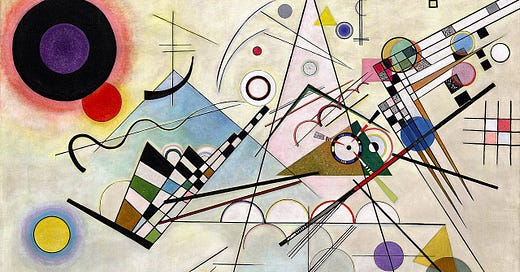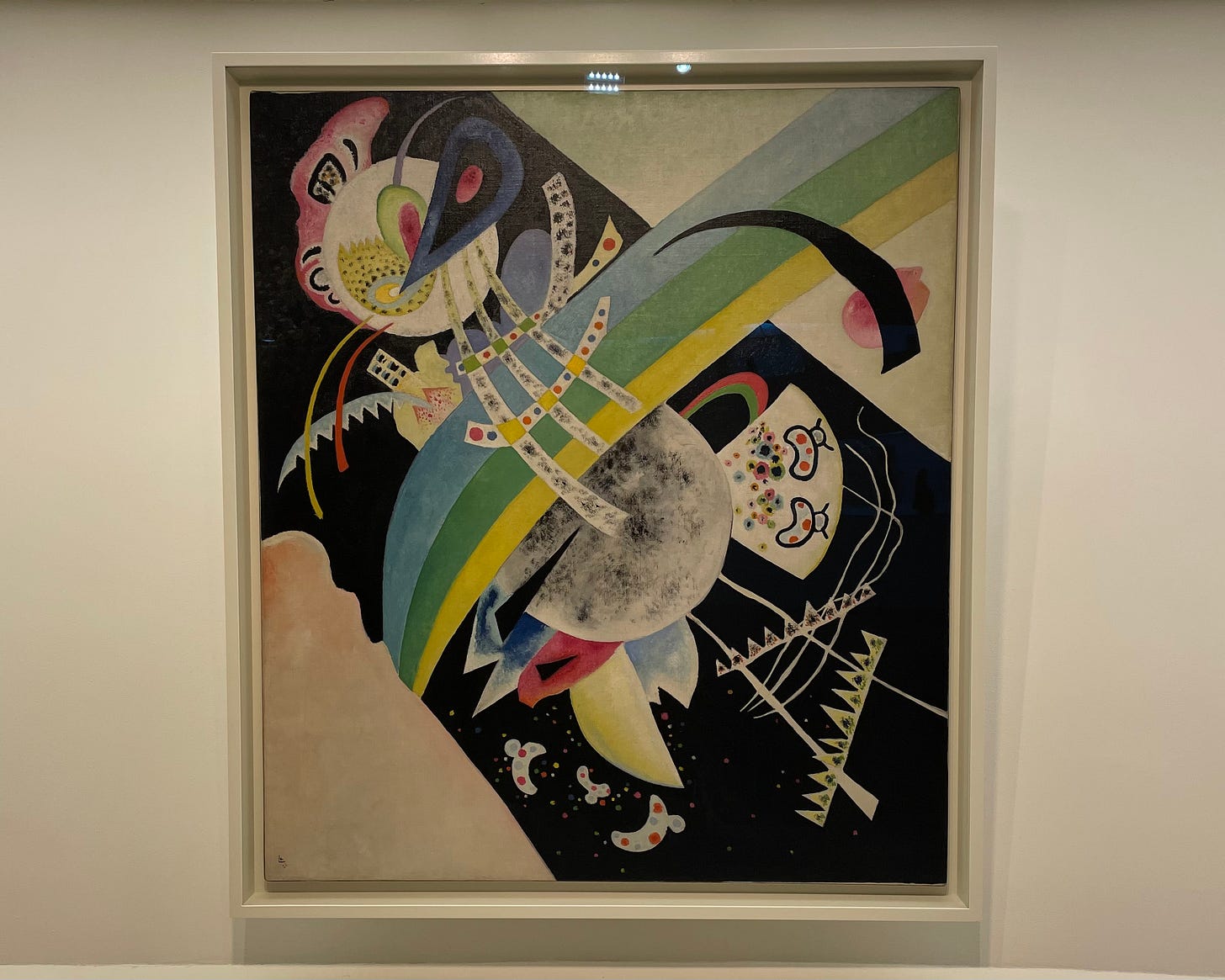Wassily Kandinsky spent a lot of time thinking about how to be weird. The Russian painter, whose best-known work is a bunch of sloppy concentric circles, was as much an academic as he was an artist. He believed strongly in the ability of abstraction to represent human emotions more credibly than figurative work — and moved around Europe through waves of political instability to encourage painters to present something deeper than reality.
Kandinsky was adamant that abstract artists should look to musicians for an example of how to convey emotion without literalism. For Kandinsky, music, color, and painting were entwined. He was a real freak who was deliberate about the way he used the components of painting — colors, shapes, perspective — to demonstrate his academic theories about art.
The biggest Kandinsky freak I know is Steve Sladkowski, the lead guitarist in the band PUP. If you are at a PUP show and don’t know how to spot Steve, look for the guy in the Sun Ra shirt. I was curious how a professional musician — and truly, a music theory fanatic — experiences Kandinsky and how it relates to his work in a pop-punk band.
Steve and I are both outright reverent of Kandinsky’s book, “Concerning the Spiritual in Art.” The book contains this quote, which gets at the heart of Kandinsky’s thoughts on painting and making music.
“A painter who finds no satisfaction in mere representation, however artistic, in his longing to express his inner life cannot but envy the ease with which music, the most non-material of the arts today, achieves this end. He naturally seeks to apply the methods of music to his own art. And from this results that modern desire for rhythm in painting, for mathematical, abstract construction, for repeated notes of colour, for setting colour in motion.”
Kandinsky would have loved Steve, who is deliberate in how he thinks about music and the way that various sounds — components — can be incorporated into his work in a genre where simplicity is accepted. Steve loves Kandinsky enough to call me from a stop on PUP’s European leg of their tour for their new (spectacular) album, “Who Will Look After The Dogs?”
Lindsey: What are your thoughts on Kandinsky, and how has he influenced you?
Steve: I was in music school, studying jazz, right? Kandinsky, I think, had a pretty significant impact on a lot of jazz musicians from the 20s, 30s, and 40s. So I just kept seeing his art and a lot of his pieces are titled “Improvisations.” I was really interested in the through line between art and music. So I was playing in an improvised music ensemble, and we had someone doing live art while we played.
Kandinsky was one of those people who said clearly that improvising is something that works in visual art and in music, so I bought a copy of “Concerning the Spiritual in Art” and I got a lot out of it even though my understanding of color theory was rudimentary.
One thing I think about is that Kandinsky was so intent on displaying different components that would then make up one piece of art. I can understand how that would be like being in a band. Do you have thoughts on the idea of like, material deconstruction as an act of creating something new?
The component parts are the things that, to me, are the most musical about his paintings. Especially the ones that have a geometric feel to it — those components are so interesting. My favorite painting of his is “Composition 8.” You see those component parts and you can kind of be drawn into one part or another in the drawing. And then you step back and you see them together and you’re like “Holy God, these are so crazy.”
I was on the train recently and saw a woman who had a Joan Miro tattoo on her right arm that blended in to a bunch of Kandinsky components moving up her arm. I am trying to think about how to fill in some of my tattoo gaps, so I texted your wife about it and she said you have a big Kandinsky tattoo. (Ed note: I guess I’m not getting those Kandinsky tattoos now.)
It's not fully a half sleeve, but it’s approaching that. The idea was to even further abstract all of these elements from “Composition 8.”
I think I saw it in the Guggenheim for the first time when I was in my late teen or early 20s, and then when [PUP] eventually went to Australia for tour, I wanted to get my first tattoo. I didn’t know what to get, so I was like, “I’ll just do one of the Kandinsky components from “Composition 8.” Then from there, I started getting a bunch of them. Anytime I was getting a tattoo and I didn’t know what I wanted to get, I’d just pick something from “Composition 8.” So they’re all on my left bicep.
[Ed note: You can identify Steve on stage by the Sun Ra shirt and Kandinsky half-sleeve.]
So you've deconstructed the deconstruction.
Exactly.
That quote from “Concerning the Spiritual in Art” about “setting color in motion” does sound like music to me, rather than painting.
It feels so strange to say his painting is musical, but it is. It’s not a far leap for me to imagine that in the 1920s he’s hearing like — when did “Rhapsody in Blue” come out? Ok, “Rhapsody in Blue” came out in 1924 and “Composition 8” was painted in 1923.
Uh, a year apart? That’s a good find.
It feels like there was a lot of crossing over between music and art and it’s just an interesting thing for me to think about it. Like, what are the different colors — or tonal elements — in this painting? If you were to even try and reflect that sort of abstraction, there’s this way of approaching improvisation from a musical perspective. Instead of reading notes printed on a page in the traditional way, you could play a score. It’s called a graphic score and it’s a way of breaking creative habits and patterns.
It’s the kind of thing that I could totally see using if you were to “perform” a Kandinsky painting from “Improvisations” or “Compositions.”
Why not just go full Andre 3000 and make a Kandinsky album?
Well, I’ve tried stuff like that. I just haven’t put it out yet.
One thing Kandinsky says is that each piece of art is a work of its own time and cannot be replicated in the future. I was thinking about PUP and how you guys exist in a genre that has a lot of established sounds and structures. But I also think people love PUP because you guys move the pop-punk genre forward. How explicit is that idea? And what are the foundational principles of PUP the band using references and influences without becoming those references?
The thing for us has always been that you want the music and mood of the songwriting to reflect whatever ideas are trying to be expressed. It’s just the four of us in a room at the end of the day. So when we realized those were the most important components for us as a band, it was a lot easier to not worry too much about it sounding a certain way. People consider us a punk band or a pop-punk band or whatever, but really it’s just the four of us playing loud rock music.
We like hooks and melody, but not being beholden to that and actually trying to do something that is interesting for us, while still keeping what people love about the band intact without feeling like we’re repeating ourselves too much.
Like the Kandinsky quote says, I feel like being too beholden to a genre becomes an unproductive nostalgia. Broadly, I think nostalgia is dangerous. But if you’re going to have it, you want to take the nostalgic things from a genre that are sort of timeless. For punk and pop-punk, for me, it’s always been about energy and good, catchy, interesting melodies. We try to leave behind a lot of the stuff that feels dated or toxic for other reasons.
Recently, I had a great fucking time seeing Spiritual Cramp and Bad Nerves because I was like, actually I do just want to see bands that sound like the Ramones. And these guys are pretty honest about it. The guy from Bad Nerves has said “we want people to think we sound like the Ramones.” And I respect that a lot more than up-and-coming bands whose references are so profoundly obvious to me while they present themselves as reinventing the genre.
So now, if they’re not going to be really creative and original, I really just respect a band that’s like “we just want to play loud, fast, hooky, and be stupid.” Ultimately, those are just the things I like.
If the idea is basically that genre has been destroyed — or cannibalized — by whatever we get from these horrible streaming services, one of the things I still find sort of interesting is that you can see similarities or concepts and ideas from different music. You can put it into your own music — and I’m not suggesting appropriation or whatever — but there are technical elements of the guitar that you can transfer. And interesting things happen when you transfer across genres. I think that’s something I learned from seeing how visual artists try to represent music, and I think Kandinsky, probably subconsciously, had an impact on me there, you know?
You can find Steve on a stage somewhere, at a Toronto Raptors game, or searching the experimental accordion section at your record store. You can find me jaywalking while listening to “Who Will Look After The Dogs” at a volume that my phone tells me is dangerous, or at PUP’s shows in Brooklyn.







